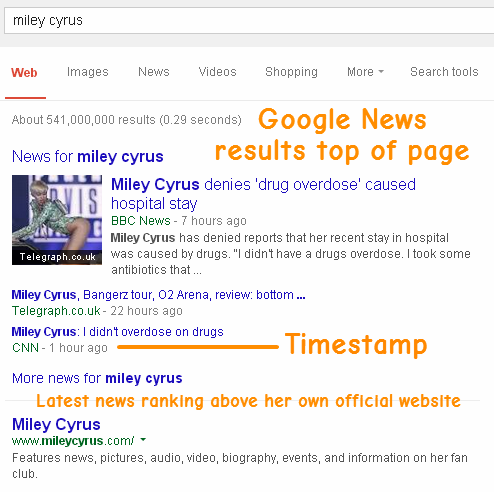
Google filed a patent back in 2003 for Document Scoring Based on Document Content Update. Basically a search algorithm that scores content based on how “fresh” it is. This patent, and the many amendments over the years that were made to the original 2003 patent, revealed Google’s direction to give more importance to websites which update their content regularly to provide fresh material for its users.
Why is fresh content important?
Fresh content has been an important ranking factor in Google’s search algorithm for years. When Google first announced their freshness update back in 2011 (eight years after that first content update patent), based off of their Caffeine infrastructure, they said that the update had impacted 35% of all search queries.
Recent information is likely to be more relevant to the user than something that was written two years ago. It might have been a spectacularly written article, ten times more in depth and far more creatively written than the article that was published today on the same topic, but its value has been reduced due to its age from Google’s perspective. Each webpage has a time decay from its inception date when Google first indexes a page or discovers it via their crawlers. The webpage’s value will degrade with time, as it becomes less relevant. But that’s not always the case. Some types of content don’t need to be fresh to still be relevant. A well known figure or event in history may not have had anything new unearthed regarding it for decades, in which case an article written about it ten years ago is likely to be just as relevant to the reader as one written ten days ago.
On the other hand, many types of content’s relevance depend entirely on how fresh the content is. So naturally Google will prioritise fresh content more for certain subjects, such as current events or topics or reviews. Google only wants to serve the most relevant of webpages to their users. It makes sense, right?
An increase in popularity for certain search queries may accelerate the “buzz” of related content, increasing a webpage’s rankings to support this increased interest in the subject and serve users what is currently a hot topic, as well as pages that have historically performed well for that query. If its World Cup season, then a search for “world cup” is going to produce search results in favour of current news related to the World Cup, over something about the World Cup from four years ago.

Google have included timestamps in their search results for a while now. That’s an indicator as to how important the age of certain pages are to not just Google but Google’s users too. People Googling for the latest celebrity scandal on, I don’t know, Miley Cyrus… They may only search for Miley Cyrus’ name but they’re expecting, and looking to click on, something recent. They’re not likely to click on something that was published months ago. Google assumes their intention or cause behind the search and serves these users recent topical results amongst Miley’s Wikipedia page and Twitter page and what have you. Google’s blended search results prioritise news articles above the rest of the organic results. But before that lightbulb flashes on above your head, getting into Google News is no east feat. You have to apply as a news site and adhere to all sorts of quality standards and technical guidelines for Google to manually approve your website to be shown in Google News.

Google evaluates the recency of content using a range of different signals, and freshness is largely based on user behaviour. An old web page that suddenly gets a natural CTR increase in the search results for a query may suggest to Google that recent or current events are making this web page more relevant to that particular search query again, refreshing it and rewarding it with a temporary boost to the rankings. Likewise, a natural sudden increase in inbound links to an old page may also signal to Google that the page has become currently relevant, boosting its freshness. As do new comments to a blog article. A steady increase of inbound links to an old page that doesn’t tend to become particularly unpopular and keeps steadily generating new comments or interactions indicates to Google that the old page is still relevant to the user’s search query and its recency is not an issue. People are still finding that the page is of worth to them, despite its age.
How do I keep my content fresh?
A highly efficient method to getting regular content up on your existing website is by implementing a CMS (Content Management System) such as WordPress to update your audience on what’s new via a blog. Blogging has become an essential element of any good SEO strategy. A blog provides you with a way to create more content pages, without it dramatically affecting the structure of the rest of your website. It is one of the most effective ways of introducing new content to your website in a non-obtrusive way, as well as attracting a new audience to your website and your product or services.
If you already have a blog, you may notice that pages that once ranked well have slipped over time. You could consider updating old blog articles with new information so that the content becomes more currently relevant, giving them the kiss of life and bringing them back into the Google game. But this shouldn’t be your main content strategy. You can’t be recycling the same posts over and over again in hopes that Google notices that you’re, at least, trying.
Making big changes to a website will refresh the page’s content. Changing a word or two, or adding a mere couple of sentences, won’t largely impact the freshness of the page but, of course, changing a word or two on a page isn’t pointless perfection either. An important keyword added in just the right place may still give you a significant boost in your rankings, just not necessarily for freshness.
As for the content to put on your blog… you may be wondering how you’re ever going to come up with that much material to be able to publish as regularly as you would like. Perhaps you’re not in an industry where interesting things happen every week and everything is just continually evolving. Not to worry. You shouldn’t be forcing yourself to pump out thin content of very low value multiple times a week that do nothing but add a new worthless page to your website. That’s not going to win you any sweet, delicious Google brownie points. But consider this: would you be able to produce an indepth guide or article once a month? Something that’s going to be well written, in depth and extremely valuable to the reader. You could use these timeless subjects for working on the page’s long term ranking. If you think you’ve burnt out all your blog post ideas, you could go even further with your efforts by analysing patterns in recent search trends and incorporating the subject into a unique article relevant to your niche.
A great way to revive a website’s homepage that has static content is to include a new section, perhaps below the fold, that pulls in the most recent blog posts or displays some kind of news feed.
A surprising number of webmasters make the mistake of thinking, “I have a website! That’ll just sit there now and serve its purpose. Job done, nuff said”. If only it were that easy… Just because you build it, doesn’t mean that they’re going to come. That’s just not how it works in this digital world where everybody’s pulling everybody in all sorts of directions. You can’t just build something then leave it. By updating your website regularly with new information, you are increasing the frequency of visits from search engine crawlers. You have to strategise a way to benefit from Google’s bias toward fresh content. Your website is constantly going out of date. The internet is a living, breathing thing that moves faster than you can type and you’re going to have to just keep up…


Thanks for submitting this to the Blogging + Business Collective. All submissions get pinned to Pinterest. Have a great Sunday!